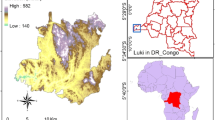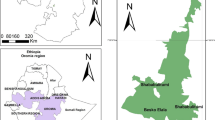Abstract
Quantifying the contribution of forest income to household’s total income, especially the poorest, is important to understand rural livelihoods, causes of poverty and designing effective development and conservation strategies. Based on a large-scale household investigation of 1495 rural households of 82 villages in 7 provinces in China in 2014–2015, this study used descriptive statistical analysis and built multilevel models to explain individual heterogeneity. Results showed that: (1) the poorest households are the less dependent on non-farm income than other households due to fewer non-farm work opportunities; (2) forest income is important for all households, although poorest ones relied more on forests; (3) the average forest income of households in the richest group is three times as much as that of households in the poorest group; (4) forest income can be increased with more land accessible to the poor and fairer harvest quota applying system. Improving roads condition and increasing forest cooperatives increase household forest income as well. The findings of this paper will be useful in designing alternative policies to alleviate poverty and protect forest resources.




Similar content being viewed by others

Notes
The reform guarantees farmers the long-term and stable rights to manage the collective forestland and own the forest property; these rights have inspired farmers’ enthusiasm to manage their forests and have improved the farmers’ livelihoods (He and Zhu 2014).
KPFPs include the Sloping Land Conversion Program (SLCP), the Desertification Combating Program around Beijing and Tianjin (DCBT), the Wildlife Conservation and Nature Reserve Program (WCNR), the Industrial Timber Plantation Program (ITPP), and the Shelterbelt Development Program (SBDP).
For additional detail about PEN, see its website at http://www1.cifor.org/pen.
Forests in China are divided into two categories—public welfare forests and commercial forests. Most of the public welfare forests are given priority in terms of protection, and logging in them is forbidden. The government compensates the households that own public welfare forests for their losses.
The SLCP was instituted to stop the farming of land that is steeply slope or is prone to soil erosion and to promote the planting of trees instead. The SLCP introduced a fixed-payment incentive mechanism to compensate rural households that participate.
An economic forest (cash tree) is a type of forest that produces mainly fruits, edible oils, industrial raw materials, medicinal herbs, and other non-wood forest products.
The main wild resources gathered are Chinese herbal medicines, such as Chinese caterpillar fungus, unibract fritillary bulb, rhizoma coptidis, rhizoma gastrodiae, grifola, eucommia bark, poria cocos, and honeysuckle.
References
Angelsen A, Wunder S (2003) Exploring the forest-poverty link: key concepts, issues and research implications. CIFOR Occasional Paper no. 40. Center for International Forestry Research, Bogor
Angelsen A, Jagger P, Belcher B, Hogarth NJ, Bauch S, Börner J, Smith-Hall C, Wunder S (2014) Environmental income and rural livelihoods: a global-comparative analysis. World Dev 64(1):S12–S28
Bennett M (2009) Markets for ecosystem services in china: an exploration of china’s “eco-compensation” and other market based environmental policies. Forest Trends Association, Washington
Cavendish MWP (2000) Empirical regularities in the poverty–environment relationship of rural households: evidence from Zimba-bwe. World Dev 28(11):1979–2003
CIFOR (2007) PEN technical guidelines version 4. Bogor, Indonesia: Center for International Forestry Research http://www.cifor.org/pen/re-search-tools/the-pen-technical-guidelines.html
De Janvry A, Sadoulet E, Zhu N (2005) The role of non-farm incomes in reducing rural poverty and inequality in China. CUDARE Working Paper 1001. Department of Agricultural and Resource Economics, UCB
FAO (2008) Links between national forest programmes and poverty reduction strategies. Forestry Policy and Institutions Working Paper 22. Food and Agriculture Organisation of the United Nations, Rome
FAO (2010) Global forest resources assessment 2010. FAO Forestry Paper 163 Rome: Forestry Department, Food and Agriculture Organization of the United Nations
Gao M, Xu TX, Zhu X, Wang L (2012) An analysis of characteristics and efficiency of resource allocatin by farmer households in poor areas with part-time business activities. Comparative Economic and Social Systems 2:163–169
Gelman A (2006) Multilevel (hierarchical) modeling: what it can and cannot do. Technometrics 48(3):432–435
Gelman A, Hill J (2006) Data analysis using regression and multilevel/ hierarchical models. Cambridge University Press, Cambridge
Haggblade S, Hazell P, Reardon T (2002) Strategies for stimulating poverty-alleviating growth in the rural nonfarm economy in developing countries . EPTD Discussion Paper #92. World Bank, Washington
He D, Zhu DL (2014) The collective forest tenure reform monitoring observations in 2013. For Econ 4:23–29 (Chinese version)
Hogarth NJ, Belcher B, Campbell B, Stacey N (2013) The role of forest-related income in household economies and rural livelihoods in the border-region of Southern China. World Dev 43:111–123
Hox J (2002) Multilevel analysis: techniques and applications. Lawrence Erlbaum Associates, Mahwah
Jagger P (2012) Environmental income, rural livelihoods, and income inequality in western Uganda. For Trees Livelihoods 21(2):70–84
Katsigris E, Xu J, White A, Yang X, Qian W (2010) Forests and income in China: part 1. Rights and Resources Initiative, Washington
Liu Y, Xu Y (2015) Geographical identification and classification of multi-dimensional poverty in rural China. Acta Geogr Sin 70(6):993–998
Liu D, Xie C, Liu J, Peng W, Yuan M, Huang D (2011) China’s conversion of cropland to forests program: development frame-work, economic impacts and future challenges. 55th Annual Austra-lian Agricultural & Resource Economics Society Conference 2011, February 8–11, Melbourne
Lohmar B, Somwaru A (2002) Does China’s land-tenure system discourage structural adjustment? China’s food and agriculture: issues for the twenty-first century. Economic Research Service, USDA, Washington
Lu W, Landell-Mills N, Liu J, Xu J, Liu C (2002) Getting the private sector to work for the public good: Instruments for sustainable private sector forestry in China (Instruments for sustainable private sector forestry series). International Institute for Environment and Development (IIED), London
Orlik T, Rozelle S (2008) China’s land reform: speeding the plough. Far East Econ Rev 171(9):18–21
Papke LE, Wooldridge JM (1996) Econometric methods for fractional response variables with an application to 401(k) plan participation rates. J Appl Econ 11:619–632
PEN (2007) PEN technical guidelines, version. Poverty Environment Network. http://www.cifor.cgiar.org/pen/_ref/tools/index.htm. Accessed June 16, 2008
Peng JT, Zhou Y, Ren XD (2010) The analysis for the suitable forest dependence level of the community on the edge of forest—a case study in Fanjing mountain nature reserve. For Econ 9:120–124 (Chinese version)
Rayamajhi S, Smith-Hall C, Helles F (2012) Empirical evidence of the economic importance of Central Himalayan forests to rural households. For Policy Econ 20:25–35
Stark O, Taylor JE, Yitzhaki S (1986) Remittances and inequality. Econ J 96:722–746
Sunderlin WD, Dewi S, Puntodewo A, Muller D, Angelsen A, Epprecht M (2008) Why forests are important for global poverty alleviation: a spatial explanation. Ecol Soc 13(2):3545–3549
Tieguhong JC, Nkamgnia EM (2012) Household dependence on forests around Lobeke National Park, Cameroon. Int For Rev 14(2):196–212
Vedeld P, Angelsen A, Sjaastad E, Berg GK (2004) Counting on the environment: forest incomes and the rural poor. Environment Department Papers, Paper No. 98, Environmental Economics Series. The World Bank, Washington
Vira B, Kontoleon A (2010) Dependence of the poor on biodiversity: which poor, what biodiversity. In CPRC international conference
Wang C, Virginia M (2012) Evaluation of economic and social impacts of the sloping land conversion program. A case study in Dunhua county China. For Policy Econ 14(1):50–57
Wang XY, Zhang H, Zhan SH (2015) Evaluation of poverty in development and poverty effect. J Chin Acad Gov 1:79–83 (Chinese version)
Weyerhaeuser H, Wilkes A, Kahrl F (2005) Local impacts and responses to regional forest conservation and rehabilitation programs in China’s northwest Yunnan province. Agric Syst 85(3):234–253
World Bank (2009) From poor areas to poor people. China’s evolving poverty reduction agenda: An assessment of poverty and inequality in China. Washington, DC: Poverty Reduction and Economic Management Department, World Bank
Xu JD (2014) The 8th forest resources inventory results and analysis in China. For Econ 3:33–39
Xu J, Xu Z (2007) Are the poor benefiting from china’s land conservation program? Environ Dev Econ 12(4):593–620
Zhou YX (2013) The role of social capital in the income of rural household: evidence from CHIPS 2002. Econ Rev 4:47–53 (Chinese version)
Zhou ZQ, Zhong QL, Cheng DL (2011) Supporting reforms of collective forest tenure system. For Invent Plan 36(1):73–79 (Chinese version)
Acknowledgements
For their constructive suggestions and help in this research, we are grateful to Professor Yaoqi Zhang from School of Forestry and Wildlife Sciences, Auburn University and Chunping Mei, Ph.D. from Antwerp University. The Natural Science Foundation of China (71373024) and Social Science Project of China supported this research (11&ZD042).
Author information
Authors and Affiliations
Corresponding author
Rights and permissions
About this article
Cite this article
Wei, D., Ben, M., Bo, S. et al. Dependence of the Poor on Forest Resources: Evidence from China. Small-scale Forestry 16, 487–504 (2017). https://doi.org/10.1007/s11842-017-9366-1
Accepted:
Published:
Issue Date:
DOI: https://doi.org/10.1007/s11842-017-9366-1



